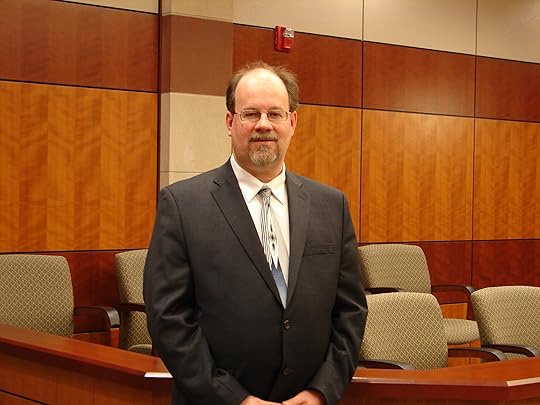Michael Kitchen's Blog, page 32
February 18, 2013
“Written in the Mitten” on Amazon
Did you miss the launch party for Written in the Mitten 2013: A Celebration of Michigan Writers? It’s available now on Amazon.
I have three pieces published within.
“With Prejudice” (short story)
“Walking Together” (personal essay)
“The Word of the Day is ‘Trust’” (short story).


February 16, 2013
February 15, 2003…The story’s not over.
It was mid-February, 2003, when I was in Fort Lauderdale, Florida for a conference. The weather was pleasant enough – 70′s and 80′s during the day, 60′s in the evening. But there I was, in my hotel room, with the heater kicked on high, wearing sweats under the blankets. I must have had it up over 80 degrees in the room, but I was still chilled to the bone.
The reason I recall this is because Common Dreams published Phyllis Bennis’ article reflecting on the tenth anniversary of the worldwide protest against the United States’ push for invading Iraq.
Saturday, February 15, 2003, I was one of among twelve to fourteen million people around the world, and between 1,350-1,650 people in Detroit, participating.
I remember it being a very very cold day. A group of us met at the University of Detroit Mercy School of Law, and together we walked to Grand Circus Park. I had my photo-journalist vest over my winter gear, to carry both my zoom and normal lenses and plenty of film. We arrived after the speeches had begun, the crowd surrounding the Hazen S. Pingree statue. Then, we walked. The group holding signs, chanting, and walking in step with the cadence of drummers, proceeded down Washington Boulevard toward Cobo Hall. I snapped off photo after photo, while chanting with the crowd. The cold seemed less severe for a while.
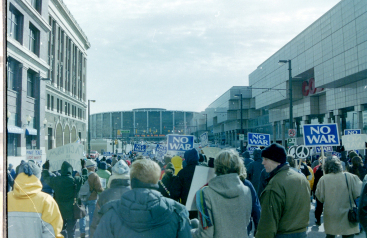
February 15, 2003. Metro-Detroiters march with the world in protesting the United States planned invasion of Iraq. Photo by Michael Kitchen.
As the march concluded at Cobo Hall, many sought warmth within. The annual Boat Show was taking place, yet anti-war protesters occupied the vast lobby. My wife, not comfortable in confined spaces, backed away towards the windows as I moved in to stand with a circle of drummers. The drumming echoed within the great lobby of the hall, drawing protesters and curious Boat Show visitors. I noticed a ring of Detroit Police Officers begin to circle the drummers, but I maintained my position, snapping photos in rhythm. The officers were rather close, standing mere steps behind each drummer, but no action was taken.
After several minutes, I decided to turn around, locate my wife, and decide what we were going to do next. I was surprised to find her standing within steps of me. We maneuvered our way out of the crowd and she informed me that something almost happened. She told me that as the police officers were converging, one held a radio communicating to the others. An officer next to her tapped her shoulder and pointed directly at me (I did not see this happen), and called the troops off from breaking up the drum circle. I can only assume that they thought I was the press and photographs of officers breaking up the drummers wouldn’t reflect well on the Department.
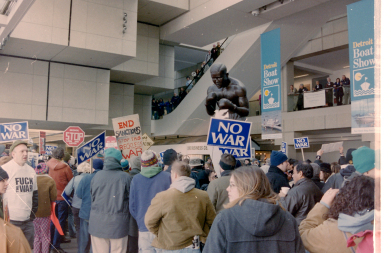
February 15, 2003. Metro-Detroiters in Cobo Hall as part of the world’s protest against a US invasion of Iraq. Photo by Michael Kitchen
Upon reflection ten years, we didn’t stop President Bush from engaging in an illegal, immoral invasion of Iraq. We didn’t prevent the deaths of 110,000-120,000 (and counting) Iraqi citizens. But as Bennis said in the soon-to-be released “We Are Many” documentary, the February 15, 2003 protest “set the stage for movements to come;” movements like the Arab Spring and Occupy.
Frederick Douglass said, “The limits of tyrants are prescribed by the endurance of those whom they oppress.” Well, at the 2-15-2003 protest and all marches I’ve attended up to Occupy, one of the echoing chants is “Ain’t no power like the power of the people cuz the power of the people don’t quit.”
I needed the heat within that Fort Lauderdale hotel room in 2003 to restore my physical body to full strength from the flu I contacted that cold Saturday. Little did I conceive the long-term impact of our participation. Thinking that the chapter of the history book had closed with Bush’s invasion a little over a month later, it was just the first page of a story that is still being written.
Tyranny, like hell, is not easily conquered; yet we have this consultion with us, that the harder the conflict, the more glorious the triumph…
A noted one, who kept a tavern at Amboy, was standing at his door, with as pretty a child in his hand, about eight or nine years old, as most I ever saw, and after speaking his mind as freely as he thought was prudent, finished with this unfatherly expression, “Well! give me peace in my day.” [A] generous parent would have said, “If there must be trouble, let it be in my day, that my child may have peace.
Thomas Paine, from an address written in 1776, and read aloud by order of George Washington to the encampment at Valley Forge. (Source: Occupy: Scenes from Occupied Amercia Verso Books, 2011)


February 9, 2013
Understanding your sports fanatic friend.
 According to the countdown clock on the Columbus Crew website, there are 35 days and change until the league’s opening match to the 2013 season. And closer to home, Detroit City FC’s season is to begin a couple months later. The excitement of the coming season has risen to a fever pitch with me. Last year, I attended more live soccer matches than in previous years. Even taking out DCFC’s full eight match season, and the handful of games I saw the Michigan Bucks play, my trips to Columbus tripled to see the Crew in action.
According to the countdown clock on the Columbus Crew website, there are 35 days and change until the league’s opening match to the 2013 season. And closer to home, Detroit City FC’s season is to begin a couple months later. The excitement of the coming season has risen to a fever pitch with me. Last year, I attended more live soccer matches than in previous years. Even taking out DCFC’s full eight match season, and the handful of games I saw the Michigan Bucks play, my trips to Columbus tripled to see the Crew in action.
This entry is for friends, family and loved ones of the person known as a sports fanatic. The person you know who schedules their life around games; who bleeds the colors of their team and goes to extremes to follow their team; who seems to care little about the mundane things in life, or even the important things. I hope that by the end of this writing, you will understand your friend, family member, or loved one better.
I recently finished reading Nick Hornby’s classic, Fever Pitch. It is a no-apologies memoir of sports fanaticism. Hornby is a rabid Arsenal fan, and his journal of matches and how they relate to his life reveals the mindset of a team loyalist, while also addressing issues within the sport of soccer, (racism, stadium tragedies, etc). His life is marked and connected to the Arsenal.
There is one passage in Hornby’s book that really sinks in. He described his greatest moment ever.
On May 26, 1989, Arsenal’s last match of the season was at Liverpool. In order for Arsenal to win the championship, they would have to beat Liverpool by two goals. The Gunners scored early in the second half, but Hornby had resigned to defeat as the game went into stoppage time. Then Michael Thomas burst through the Liverpool defense and scored, giving Arsenal the league championship and Hornby a moment of delirium.
In seeking a metaphor to describe the feeling, Hornby declined the orgasm analogy, and stated why:
Even though there is no question that sex is a nicer activity than watching football (no nil-nil draws, no offsidetrap, no cup upsets, and you’re warm), in the normal run of things, the feelings it engenders are simply not as intense as those brought about by a once-in-a-lifetime last-minute Championship winner.
None of the moments that people describe as the best in their lives seem analogous to me. Childbirth must be extraordinarily moving, but it doesn’t really have the crucial surprise element, and in any case lasts too long; the fulfillment of personal ambition – promotions, awards, what have you – doesn’t have the last-minute time factor, nor the element of powerlessness that I felt that night. And what else is there that can possibly provide suddenness? A huge pools win, maybe, but the gaining of large sums of money affects a different part of the psyche altogether, and has none of the communal ecstasy of football.
There is then, literally, nothing to describe it. I have exhausted all the available options. I can recall nothing else that I have coveted for two decades (what else is there that can reasonably be coveted for that long?), nor can I recall anything else that I have desired as both man and boy. So please, be tolerant of those who describe a sporting moment as their best ever. We do not lack imagination, nor have we had sad and barren lives; it is just that real life is paler, duller, and contains less potential for unexpected delirium. (Nick Hornby, Fever Pitch, [Riverhead Books, 1998], 222-23).
Hornby reminded me a lot of myself back in my hockey fan days. It became an obsession applied when I was the president of the Ontario Hockey League team, Detroit Jr. Red Wings (currently known as the Plymouth Whalers) for two seasons. Then, the Detroit Vipers claimed the Palace of Auburn Hills home, and my passion settled in a permanent location.
In 1997, I was fortunate to be photographing Detroit Vipers games for my friend’s hockey publication. The Vipers ended the season with the best record, and marched through the Turner Cup playoffs. Where games were proximately close (like Kalamazoo and Cleveland) I would make the trip for at least one of the road games. Their opponent in the Turner Cup Finals was the equally tough Long Beach Ice Dogs who had an ungodly undefeated streak at home.
The format was two games at the Palace, three in Long Beach, then back home for two games, if necessary, in Detroit. The teams split the games at the Palace, and it seemed unlikely that the series would end in Long Beach. But the Vipers pulled the surprise, winning the next two games in California, taking a 3-1 lead in the series and the potential of winning the Cup in Long Beach on a Friday night.
So damn close to being with the winners, I decided I had to make the flight to LAX and get to that game. However, the Ice Dogs would not go down at home, and I had to get back to Detroit for the Father’s Day, Sunday evening Game Six of the series. The Vipers won, 2-0, the on-ice festivities and locker room partying will never be forgotten.
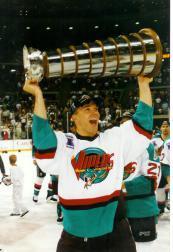
Patrice Tardif hoists the Turner Cup. Photo by Michael Kitchen
It was one of those moments that Hornby described. Following hockey for so long, this was unlike anything I ever experienced. Not being an athlete myself, I never thought I’d ever come this close to this sensation. It remains the greatest moment in my life. Even though I wasn’t on the ice, delivering a check or setting up a goal that made a difference in the game, I was a part of it. All I was doing was shooting film. Having been situated between the players’ benches all season, I was there in the trenches. When I was in the Long Beach Ice Dogs’ building ninety minutes prior to Game Five, Phil von Stefenelli – one of the Vipers’ defensemen – was going through his pre-game ritual outside the locker room, and gave me the nod of recognition and camaraderie.
I get the Hudson Street Hooligans of the Columbus Crew. I get the Northern Guard Supporters and Motor City Supporters as they cheer and chant in the filled to capacity visitor’s bleachers at Cass Tech High School for the Detroit City FC games.
Hopefully, this helps you understand your sports fanatical loved one. He or she has developed a deep emotional connection to their team performing on its athletic stage. I can’t speak for all fanatics, but after that once-in-a-lifetime moment comes true, it opens one up to new avenues. But the connection never dies. The Detroit Vipers became defunct in 2002, but it will always be my favorite hockey team. And though Columbus Crew and Detroit City FC have arteries running into my ventricles, I don’t feel a need to have my life consumed by them. I still will attend every DCFC home game, and will make one or more trips to Columbus, my vacation soccer home, and make sure I can see as many of their matches on the tellie.
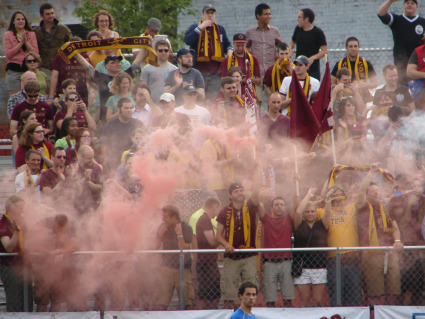
Detroit soccer fanatics celebrate a Detroit City FC goal at Cass Tech High School, Detroit, 2012. Photo by Michael Kitchen


February 5, 2013
Huffington Post photo credit
The Huffington Post graciously contacted me today about using a photo of mine for their story, Louisiana Hines Dead: World’s Oldest African American Dies at 113.
The photo was taken at the 90th Birthday Celebration of Erma Henderson, on August 31, 2007 at Cobo Hall in Detroit. Erma is featured in the second photo holding Ms. Hines’ hand as she spoke about Erma.


My website is done!
I finally had a website created for my law practice. You can get to it using any one of three ways:
If you get a chance to take a peek at it, let me know what you think!


February 2, 2013
DoHaeng’s Ideal Bookshelf
What’s on your bookshelf?
In November, 2012, Little Brown published a collection of essays titled My Ideal Bookshelf. It was edited by Thessaly La Force, who collected one-page essays from more than one hundred leading cultural figures on the books that mattered to them the most. As the inside flap reads, “books that define their dreams and ambitions and in many cases helped them find their way in the world.”
Each essay was accompanied by a picture of the bookshelf, painted by Jane Mount. Not only is it interesting to learn what other cultural icons have read that inspired them, but that you can commission Ms. Mount put to canvass a painting of your own ideal bookshelf.
Not to begrudge Ms. Mount her art, but wall space is scarce in my abode. So instead, I took to two of my favorite endeavors – book shelf arranging and photography – and created a photo of my ideal book shelf. Fortunately, the former Borders bookshelf was tall and deep.
An ideal book shelf, in my view, would reflect the influences on one’s life and the many dimensions to the person’s being. Thus, my ideal book shelf covers a range of topics.
The comic book period represents the emergence to adulthood. The comic book collections I’ve chosen are those that came at that edge of time where childhood immaturity traversed into more mature themes and characters. And to this day, American Flagg!, Nexus, The Question, and Watchmen can be appreciated by the adult.
Then, there are the books that started me on the path of writing. It was of course the encouragement of people in writing classes and friends that caused me to begin putting pen to paper the makings of my imagination. Early guidance through books introduced freeing lessons which released me from inhibitions. I was never told by a professor that I was free to write the worst junk in the world. But Natalie Goldberg blew open that door, freeing me from the rigid cold hand of immediate perfection.
There are the books that guided me to the Zen Buddhist path, both early on in my young adult life, and to more recently upon finding a Zen temple to experience Zen practice; something that you cannot honestly achieve through reading a book.
There are the nonfiction books that provide the uncompromising hard facts about the world that those in the mainstream media force us to ignore. Such powerful journalism and activism –whether it be political issues or exposure of the cultish positive thinking gurus – confirmed the guttural feelings of illusion that profit-first seekers cast over us. And of course, sport. Space limited me to choose from hockey of the past to soccer of the present, so I selected three soccer books that I have found as compelling and entertaining as the sport itself.
Down Through the Years: The Memoirs of Detroit City Council President Emeritus Erma Henderson is also there. It is not only because I co-wrote the book with her, but the influence she had on my life as well as my family’s. To me, it was more than the writing of my first (and currently only) book-length publication, but a period of growth intellectually and a leap of the maturation process.
Finally, there is the fiction that has inspired me to write; the authors and novels and short fiction whose writing I enjoy and hope to emulate. Topping that list is my favorite novel, The Razor’s Edge by W. Somerset Maugham. It is the story – depicted in Maugham’s print, and by films in 1946 starring Tyrone Power and 1984 starring Bill Murray – that is the source inspiration of my writer’s soul.
At the back of My Ideal Bookshelf, there are ten blank book covers to fill in with your own top ten. The photo of my shelf far exceeds that. Which of them would make the top ten?
1. The Razor’s Edge by W. Somerset Maugham.
2. The Antidote: Happiness for People Who Can’t Stand Positive Thinking by Oliver Burkeman.
3. The Autobiography of My Body by David Guy.
4. The Still Point Dhammapada by Geri Larkin
5. Watchmen by Alan Moore and Dave Gibbons
6. Enough Rope: Collected Short Stories by Lawrence Block
7. American Flagg! Volume One by Howard Chaykin
8. The Question by Dennis O’Neil and Denys Cowan (all six volumes).
9. A People’s History of the United States by Howard Zinn
10. The Historian by Elizabeth Kostova.


January 23, 2013
Awe-inspired living.
In Oliver Burkeman’s book, The Antidote: Happiness for People Who Can’t Stand Positive Thinking, I resonated with a statement he feels is the best description of a true happiness that is worthy of experiencing.
Paul Pearsall writes “Awe is like trying to assemble a complex jigsaw puzzle with pieces missing. There’s never any closure in an awe-inspired life. We’re never allowed to know when this fantastic voyage might end…but that’s part of the life-disorienting chaos that makes this choice so thrillingly difficult.” (Burkeman, pg 211, quoting Pearsall in Awe: The Delights and Dangers of Our Eleventh Emotion (Deerfield Beach Florida: Health Communications, 2007).
Ponder that for a moment.
Awe leaves nothing out. It is happiness, joy, love, anger, sorrow, fear, amazement, boredom, achievement, failure, all wrapped into one experience – life. Embracing only the “positive” emotions and thoughts – as those preached by the cult of optimism – actually limits one’s experience of an awesome life. But it is a deeper, difficult, and authentic experience compared to the superficial “grinning insistence of optimism at all costs, or the demand that success be guaranteed.” (Burkeman, pg. 211).
There is no “30-day plan” to happiness or success. Now matters; not what might happen a month from now. And it’s the realization and acceptance that some experiences and situations cannot be explained. It is okay to rest in uncertainty.
Awe, to me, is a balance of these positive and negative emotions. It is not wearing rose-colored contact lenses trained on the future, nor being a prophet of doom based on the events and writings of the past. The awe-inspired life happens right now. Because that’s all we really have.

Photo by Michael Kitchen


January 17, 2013
The 40-year relationship is over.
January 19th, the NHL season will finally get underway. I really don’t care.
This should concern me (and anyone who really knows me). I marveled at the sport ever since the days of my youth. And even though I’ve never had an athletic bone in my body, in gym class I excelled at floor hockey.
I wasn’t a casual viewer. No, I was someone who…
still has the program from the first hockey game I attended live (January 9, 1971, Detroit Red Wings vs Buffalo Sabres at the Olympia in Detroit). Larry Brown is on the cover, and the Wings won 3-2;
collected hockey cards from 1970 up through the late 1990′s;
shared two season tickets to the Red Wings for three seasons (1989-90, 1990-91, and 1991-92);
was the booster club president for the Detroit Jr. Red Wings of the OHL (currently known as the Plymouth Whalers) for two seasons (1992-93 and 1993-94);
photographed the Detroit Vipers of the International Hockey League (IHL) and wrote a column in a local hockey publication for the 1996-97 and 1997-98 seasons (Great Lakes Hockey Alliance);
traveled to places like Kalamazoo, MI; London & Niagara Falls & Owen Sound, Ontario; Montreal & Quebec City, Quebec; Long Beach, CA; Buffalo, NY; and Cincinnati, OH to watch live hockey;
was the commissioner of a fantasy hockey league that spanned over a decade; and
continues to wear vintage Detroit Vipers jackets appropriate for the season.
Why is this forty-year relationship coming to an end? Perhaps the sport and I have just grown too far apart.
The first signs occurred after the IHL folded. In 1994, the Detroit Vipers emerged at the Palace of Auburn Hills, which provided quality, entertaining and affordable hockey. The IHL was a minor hockey league dating back to 1945. With the NHL locking out its players during the 1994-95 season, the IHL expanded into areas to compete with NHL franchises. Along with Detroit, the league added teams in Minnesota and Chicago.
I followed the Cincinnati Cyclones the year previous, as my sister and her family lived across the Ohio River in Kentucky. But it didn’t take long for my blood to flow the aqua and eggplant of the Vipers. I attended the team’s very first game (a 7-3 victory over the Cleveland Lumberjacks on September 30, 1994) and their very last game (a 3-2 victory over the Orlando Solar Bears on April 14, 2001) at the Palace. I still have my photo passes for the June 15, 1997 game where they won the Turner Cup against the Long Beach Ice Dogs, and the October 3, 1997 game where Gordie Howe took to the ice for one shift as a Viper. The memories are endless, and all of them fond. The Vipers folded, and my passion for the sport waned.

Stan Drulia of the Detroit Vipers
Photo by Michael Kitchen
NHL ownership greed pushed me away. Three lockouts which shortened this season and the 1994-95 campaign, and completely cancelled the 2004-05 season. How does a tradition establish and maintain itself with this kind of off-ice instability? Such gaps provide the opening for other interests to emerge.
The game itself went in another direction. For each step forward that the league made, such as the elimination of the two-line pass, the game retreated a couple of steps because of the oppressive push to eliminate fighting from the game. I’m not the biggest fan of fighting, but the role of the enforcer insured that players were held accountable for their brutal acts on the ice. With that element removed, players have been able to injure each other with intent, and the league assuming punishments of suspensions and fines would provide adequate retribution.
The first game I attended back in 1971, no one wore a helmet. In fact, the Buffalo goaltender, Joe Daley, didn’t wear a mask. In those days, you didn’t have the concussions and injuries to superstars that you have in today’s game. The addition of helmets and goalie masks are acceptable safety precautions. However, it has lessened respect for each other on the ice, and the elimination of instant justice, coupled with the faster pace of the game has allowed for a more dangerous sport, especially for the marquee players.
Dissatisfied, frustrated, and watching the game grow away from me, a past lover returned in my life, which sparked what has become a renewed passion and rekindled love: soccer.
In 1978, I was introduced to professional soccer through the Detroit Express of the North American Soccer League (NASL). It was their first year in the league and Trevor Francis made the experience magical. Arriving after the first eleven games of the season (finishing his English season with Nottingham Forest), Francis destroyed opposing team’s defenses scoring 22 goals and 10 assists in 19 matches. The first game I saw live was July 30, 1978 where the Express defeated the Fort Lauderdale Strikers (and legendary keeper Gordon Banks) 4-2. Francis scored two goals and assisted on another. I also attended the first round playoff match – a 1-0 victory over the Philadelphia Fury, with Francis netting the only goal.
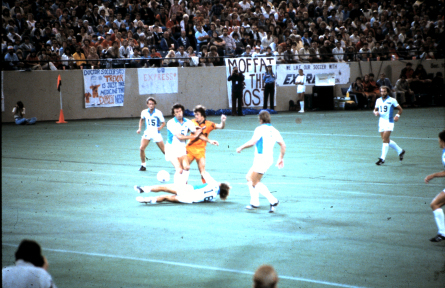
Trevor Francis triple-teamed by the California Surf.
Photo by Michael Kitchen
I got to a few more games at the Silverdome in 1979 and 1980, and watched as much of the NASL that was televised. But then I was off to college and the Express and NASL went the way of other defunct professional sports leagues.
On June 28, 2000, while vacationing and visiting friends in Washington DC, I attended a DC United match. The LA Galaxy beat DC United 2-1 that evening, but the love of the sport that had been in hibernation for 20 years was reborn. A couple years later I got to my first Columbus Crew game, and since then, there’s been no turning back.
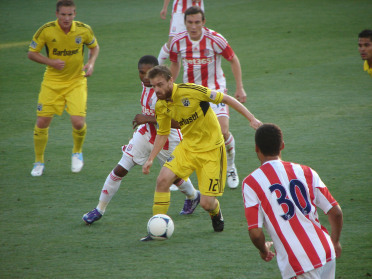
Eddie Gaven of the Crew dribbles through Stoke City of the English Premiere League.
Photo by Michael Kitchen
The hockey cards I’m slowly selling off on eBay, and in place I have almost a complete collection of every MLS card set available. I find myself able to watch, at most, a period of hockey, but I can lose two hours in the blink of an eye if Arsenal is on the telly. I do miss going to Detroit Viper games, however neither the Plymouth Whalers or Detroit Red Wings motivate me to purchase a ticket. But I’ll eagerly make the four-hour drive to Columbus for a Crew match. Given the choice, I’d take a ticket to a Detroit City FC match and sit amongst the Northern Guard, Le Rouge Supporters and Motor City Supporters than an ice level seat amongst the suits at the Joe Louis Arena.
I could conclude that the death of hockey’s influence on my life is a part of a maturing process. Other interests such as civic duties, promoting change and protesting the elements in society that promote a destructive status quo, immersing in my profession, and just trying to make the world a little bit better place then it was when I got here was prioritized higher than being entertained by sport.
Yet soccer has moved in and occupied hockey’s place in my life. Perhaps that, too, is evident of a maturing process. Hockey, despite what Gary Bettman tries to promote, is a regional sport, conducive to areas where winter’s breath creates the field of dream in backyards and ponds and streets of everyday life. Soccer is global and its fans and players are a global community. The sun never sets on the beautiful game, for I can follow Arsenal in the English Premiere League from August to May, and attend Columbus Crew matches from March through October. And with matches played on a weekly, rather than three or more times a week basis, a two-hour soccer match once a week leaves time open for other, more noble and mature pursuits.
After forty years, both hockey and I have grown in different directions. It was fun and formative. But it is time to move on.
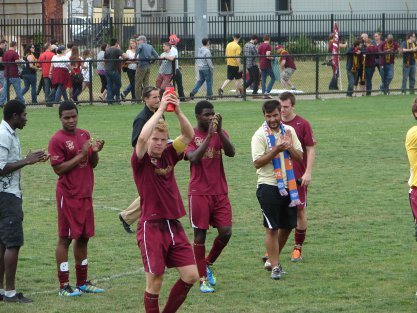
Detroit City FC thanks you for attending.
Photo by Michael Kitchen


January 7, 2013
Guns don’t kill people AND they don’t do something else.
On December 14, 2012,Adam Lanza helped himself to guns owned by his mother, to kill her and murder 20 children and 6 adults before taking his own life at Sandy Hook Elementary School in Newtown, CT. This tragedy shook the nation, and even brought tears to the eyes of the President of the United States. Since then, there has been talk, as well as the refusal to discuss, the issue of guns in the United States. Also, concern about the treatment of mental illness has emerged as questions surround whether Adam Lanza suffered from autism. Compound that with the video game burning to be held in Southington, CT., and the blame is well distributed.
Guns. Mental Health. Video Games & Movies.
Addressing these issues individually or collectively is merely focusing on symptoms of the deeper problem.
American gun enthusiasts throw out the cliché “Guns don’t kill people; people kill people,” as a mantra to protect their perceived rights to owning guns.[1] However, they, and everyone else overlook the corollary:
Guns don’t protect people; people protect people.
This is the deeper issue.
We live in a society where our media, private interests, and politicians divide us based upon our differences:
Christians vs. Non-Christians.
North vs. South.
Conservatives vs Liberals
“Majority” vs Minorities
Male vs Female
Heterosexual vs LGBT
Pro-Life vs Pro-Choice
Rugged Individualism vs Collectivism
Free Market vs Socialism
Self-Made Man vs Welfare Queen
Workers who are anti-union vs unions
Corporate interests vs the environment
Wall Street vs Main Street
Profits vs People
Journalism vs Infotainment.
Liberty vs The Government
“Americans” vs. Immigrants.
United States vs All Other Nations.
Hammering these differences and creating fear against “the other” heightens our sense of self-preservation. It is the promotion of this perpetual consciousness that allows us to witness the President of the United States with tear-filled eyes commenting on the Sandy Hook incident, yet fail to question why not a single tear is shed, or even acknowledgment of the civilians and children he and his predecessor have killed in drone strikes in Pakistan, Yemen, and Somalia.
What kind of country are we that kills other country’s children (such as three children ages 12, 10, and 8) and justify it based on a philosophy that “In addition to looking for military-age males, it’s looking for children with potential hostile intent.”?
It’s okay to kill children who have “hostile intent?” Really?
This corollary – Guns don’t protect people; people protect people – also relates to the mental illness discussion of the Sandy Hook incident. In this nation, we are marketed the idea that a single-payer health care system, whereby we, as a collective people pool our resources into one central location – the government – to cover every one’s health care costs, is somehow inferior to the “pay-or-die” system we currently have in place. The propagators of this idea are the very people who profit from the “pay-or-die” system – insurance companies, pharmaceuticals, private hospitals, and the media that reaps the financial benefits of these industries through advertising dollars. Here again, our collective mantra is not “protect myself and all others,” but rather “me first, let everyone else take care of themselves,” which is the mental and societal breeding ground for incidents like Sandy Hook.
About three years ago I had a conversation with a couple – Dominic & Anna – who were Italian immigrants to Canada. Health care was a hot button issue at the time, so I asked them about their experience with the Canadian system. Anna’s mother had moved to the Metro Detroit area, and Anna had to care for her and her late father in the United States. Anna could not believe the inhumane health care system that America has in comparison to Canada. She said that in Canada (and Western European countries like the UK, France, and Italy, where both Anna and Dominic were born), the common belief amongst its people is that we all look out for each other. “Over here,” she said, “it’s all about ‘me.’”
Guns don’t protect people; people protect people. The more we focus on that mantra versus the one the gun lobby and the citizens they’ve instilled fear into, the more sober an approach we’ll have to preventing incidents like Sandy Hook. It’s not about arming every citizen (personally, if you need an assault rifle to kill Bambi, it’s time to take up a new hobby); it’s not about denying health care or maximizing profits from those who suffer from illness; or about burning video games (it’s seems an amnesty can be achieved without such a Fahrenheit 451 spectacle). And if the President is concerned about the causes that are “desensitizing our children to acts of violence” as the Southington SOS claims in its press release regarding the video game burning, he should turn his attention to the largest perpetrator and influence of desensitized violence in our nation – the Pentagon.
Guns don’t kill people, nor do they protect people. It’s about we, as a society, choosing how we wish to live. If we’re going to be fear-based creatures, believing that everyone outside our immediate circle of family and friends is out to do us harm, whether they are in our neighborhood, city, state, country, or abroad, and therefore, we take care of our selfish interests first, and every other person for him or herself, there will be more tragedies similar to Sandy Hook. However, if we become a society like those Dominic and Anna spoke of, where we all look out for each other, imagine what a different nation this would be.
Are we a people who kill people, or a people who protect people?
The choice is ours.
[1] I say “perceived” because, throughout the history of this nation, the Second Amendment has been interpreted to protect the “militia-related, not self-defense related interests.” (Justice Breyer’s dissenting opinion in District of Columbia v. Heller,128 S.CT, 2783 (2008) Read Justice Stevens dissent, for it articulates the history of 2nd Amendment case law and is very well reasoned). It wasn’t until the Heller decision by five conservative activist judges that overturned historical precedent. “Conservatives, who for the last several decades have taken a narrow approach to individual liberties and refused to recognize new rights, had no difficulty in finding a Second Amendment right of individuals to have handguns.” Erwin Chemerinsky, The Conservative Assault on the Constitution (Simon & Schuster Paperbacks, 2010).


January 2, 2013
Heron Bay Books Launch Party
On February 16, 2013, Heron Bay Books will be hosting a launch party for its release of Written in the Mitten an anthology showcasing Michigan writers.
I have three pieces published in the anthology: The Word of the Day is “Trust” (the short story that won the 2009 Michigan Bar Journal Short Story Contest); With Prejudice (the short story that was a finalist in the 2011 Michigan Bar Journal Short Story Contest); and Walking Together – a short reflection on co-writing Down Through the Years: The Memoirs of Detroit City Council President Emeritus Erma Henderson.
The event is from 2:00 to 4:00 at the Detroit Yacht Club. Admission is free, however you MUST RSVP to receive an entrance ticket, otherwise security will turn you away at the door. You must register by January 31, 2013.
For more information about Heron Bay Books, their website is HERE.



